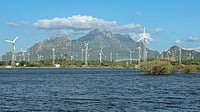The Centre has issued model rules for the felling of trees on agricultural land in a bid to promote agroforestry with the aim of doubling farmers' incomes, increasing tree cover outside forests and mitigating climate change.
In a letter sent to all state governments on June 19, the environment ministry said the objective of 'Model Rules for Felling of Trees in Agricultural Lands' is to enhance the ease of doing business in agroforestry and incentivise farmers to integrate trees into their farming systems without facing undue procedural hurdles.
The government has been promoting agroforestry to double farmers' income, enhance tree cover outside forests, mitigate climate change, reduce timber imports and ensure sustainable land use. It also supports India's climate goals under the Paris Agreement.
A key barrier is the lack of clear, harmonised rules for felling trees on agricultural land which affects cultivation and marketing of agroforestry produce, according to the ministry.
According to the model rules, the State Level Committee (SLC) already formed under the Wood-Based Industries (Establishment and Regulation) Guidelines, 2016 will also serve as the committee for these rules. It will now also include officials from revenue and agriculture departments.
The committee will advise the state government on how to promote agroforestry and increase timber production from agricultural lands by simplifying rules for felling and transit of trees, especially species with commercial value.
It will empanel agencies for verification of applications and transit of timber from agricultural lands.
Applicants must register their plantation land on the National Timber Management System (NTMS) portal. They have to enter land ownership details and the location of their agricultural land.
They must give basic plantation details, including the number of saplings by species, planting date (month and year) and the average height of seedlings.
Applicants will also have to update this information as required by the SLC.
Carbon‑Ready Agroforestry Shift
According to India’s August 2022 submission to UNFCCC, the country’s Nationally Determined Contribution (NDC) under the Paris Agreement aims to create an additional carbon sink of 2.5 to 3 billion tonnes of CO2 equivalent through increased forest and tree cover by 2030.
Additionally, India is a signatory to the Bonn Challenge, committing to restore 21 Mha of degraded and deforested land by 2030, stated the Ministry of Environment, Forest and Climate Change.
The government also seeks to accelerate existing afforestation targets like the National Mission for a Green India (GIM), now merged with the National Afforestation Program (NAP). Significant financial resources are being channelled towards these flagship programs, stated a 2024 ScienceDirect Study.
(With inputs from PTI.)
































